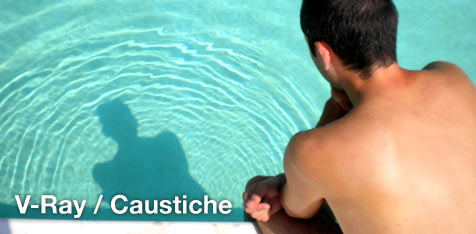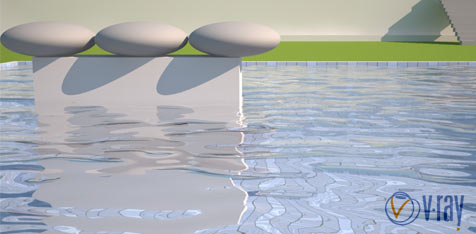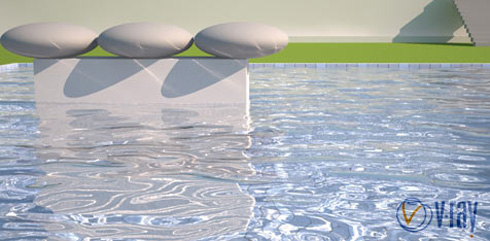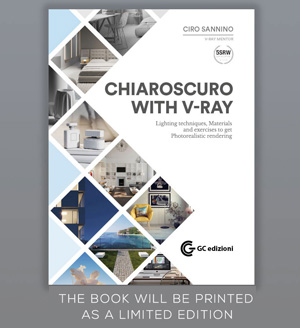
*
This post has been updated > V-Ray Caustics V2Â !
*
I went on holiday, I spent two wonderful weeks in Zante – thinking in a V-Ray Sea Simulation – and I must confess it: these days I was particularly attracted to those amazing play of light that you see on the bottom of the sea and swimming pools.
This is a physical effect that takes the name of “Caustics” and you have probably already read somewhere that you can simulate this effect with V-Ray. Let’s see how.
The light passes through a curvee and transparent body (glass, water ..) , so the light will tend to concentrate it in some areas. (Read a full explanation of caustic )
Very often we create material “Water” material using “Affect shadows” option. In this way the light passes through the object. If you do not want the caustics this  is a good solution. If you want to simulate the caustics mark “on” here:
- Panel rendering (F10) > Indirect Illumination> V-Ray Caustics > ON [X]
Here a little explainiation of the main 4 parameters you’ll find there:
- Multiplier: caustic intensity  (1,0 default = ok)
- Search dist: projection distance (..follow the tutorial)
- Max photons: maximum number of photons used to calculate (10 = ok)
- Max density: Resolution limit (0,0 default = ok)
CAUSTIC SUBDIVISION parameter:
It ‘important to manage the details of the caustic. It is governed by the value “Caustic subdivs.” you can find by clicking on Light Setting in:
– Rendering panel > Setting > Light Setting (at bottom) and checking the light: Direct Sun, in this case.
Note: In this V-Ray version I use  I prefer to use “direct light” because it works better than VRaySun
(In the attached file, “Caustic subdivs.” setting is 30000. It’s high enough to get sharped caustics. Attention: for your first test you can start using “3000”.)
As you know I love simple explanations, and especially love the “results” without too many technical and mental complications, so let’s concentrate on the main actor. Do you know who is?
>>> It’s the WATER SURFACE!
“Create a good water surface in order to get a realistic caustics effect”
Without a suitable surface the effect is never pleasant. Surely there are many ways to make a good surface that simulates the water, in this tutorial I do so:
- I create a box with a high number of subdivisions (1cm thick)
- I apply the Noise modifier with “fractal” active (Z = 1cm)
You just turn on the caustics and assign to Search. dist. a suitable distance to let the caustics “reach” the bottom. (Eg.: If the pool is 200cm deep, setup Distance search = 300cm, this value will be more than sufficient.)
In this render I just use “affect shadows”: It seems the sun doesn’t penetrate the water!

But if we activate the caustics, thus allowing the light to cross the water, generate caustics, projecting towards the bottom and upwards … then the result changes! (Unfortunately, also the rendering time)

I hope you liked my simple tutorial about V-Ray caustics!
*
This post has been updated >Â V-Ray Caustics V2Â !
 / Also Learn Corona Renderer
/ Also Learn Corona Renderer



Good tutorial, but the map “peloaqa.jpg” is missed.
Hi Stenio 🙂
peloaqa.jpg is just a missing file… but it is not used in the scene.
hey I did not any Getting reference Files
Nice Tuts By the way
Hey MITTAL!
Search in the spam or trash…
thanks for the experience or thank him vray.cam Ciro Sannino – Author, he realized who I was for light, hiii
Nice tutorial. Very useful. I’ll use it in my works.thanks for tutorial.from iran.
hey, nice tutorial, maybe we can hook up and make some projects together next time, i’m 18 years old and taking a course on 3d animation and graphic designing, i must say, awsome tutorial, simple and good. keep it up. all the best from Malaysia.
Hi i didn’t get any file. can you please send me in my email? thank you so much…. I was searching for this kind of tutorial….
Hi INGRID,
try to search in your spam emails… or try to put again your mail.
The direct link will appears 😉
I like. thanks Ciro